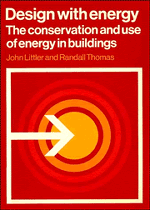Book contents
- Frontmatter
- Contents
- Units, symbols, abbreviations, conventions and conversion factors
- Preface
- 1 Energy and buildings
- 2 Site planning and analysis
- 3 Building design
- 4 Passive solar design
- 5 Active solar heating
- 6 Space heating and ventilation
- 7 Thermal storage
- 8 Wind energy
- 9 Water-supply systems
- 10 Waste disposal and utilization
- 11 Domestic-energy saving
- 12 Housing case studies
- 13 Non-domestic case studies
- Appendix 1 Weather data
- Appendix 2 Thermal performance
- Appendix 3 Interstitial condensation
- Index
Preface
Published online by Cambridge University Press: 03 February 2010
- Frontmatter
- Contents
- Units, symbols, abbreviations, conventions and conversion factors
- Preface
- 1 Energy and buildings
- 2 Site planning and analysis
- 3 Building design
- 4 Passive solar design
- 5 Active solar heating
- 6 Space heating and ventilation
- 7 Thermal storage
- 8 Wind energy
- 9 Water-supply systems
- 10 Waste disposal and utilization
- 11 Domestic-energy saving
- 12 Housing case studies
- 13 Non-domestic case studies
- Appendix 1 Weather data
- Appendix 2 Thermal performance
- Appendix 3 Interstitial condensation
- Index
Summary
The authors have rendered a valuable service to the building industry by the preparation of this volume with its wealth of actually built, rather than projected, examples. The book is well and soundly written with its emphasis maintained from start to finish on their basic theme, the necessity for the use in buildings of energy in many forms and the increasing desirability of learning how to minimize the use of non-renewable forms of energy in meeting those essential needs. Directed primarily towards architects, builders and owners in the United Kingdom, and consequently written within the scope of SI units, the book will be helpful to all who plan to build in latitudes north of the 50th parallel, where winter heating is more important than summer cooling.
Proper ventilation and the admission of outdoor air under suitable circumstances are not neglected, however. Building design features which are recommended by the authors are liberally illustrated by photographs and drawings of residential, institutional and commercial structures which actually exist. The soundness of their recommendations has been verified in most cases by the first-hand knowledge of the authors. Many of the ‘Energy’ books which have appeared in recent years have dealt almost exclusively with non-renewable forms such as the wind and the sun. These are not neglected here but their applicability is subjected to careful and objective analysis, with the intent of giving guidance which is based upon knowledge and experience rather than upon enthusiasm alone. The reader may well divide the book into three sections.
- Type
- Chapter
- Information
- Design with EnergyThe Conservation and Use of Energy in Buildings, pp. xv - xviPublisher: Cambridge University PressPrint publication year: 1984



